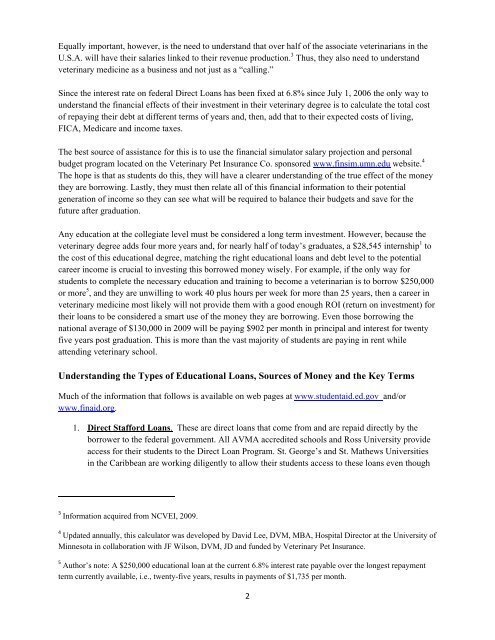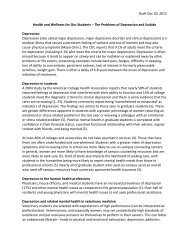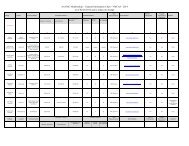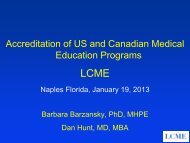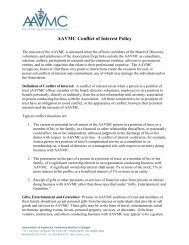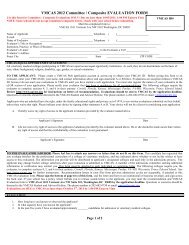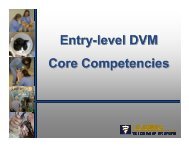Equally important, however, is the need to understand that over half of the associate veterinarians in theU.S.A. will have their salaries linked to their revenue production. 3 Thus, they also need to understandveterinary medicine as a business and not just as a “calling.”Since the interest rate on federal Direct <strong><strong>Loan</strong>s</strong> has been fixed at 6.8% since July 1, 2006 the only way tounderstand the financial effects of their investment in their veterinary degree is to calculate the total costof repaying their debt at different terms of years and, then, add that to their expected costs of living,FICA, Medicare and income taxes.<strong>The</strong> best source of assistance for this is to use the financial simulator salary projection and personalbudget program located on the Veterinary Pet Insurance Co. sponsored www.finsim.umn.edu website. 4<strong>The</strong> hope is that as students do this, they will have a clearer understanding of the true effect of the moneythey are borrowing. Lastly, they must then relate all of this financial information to their potentialgeneration of income so they can see what will be required to balance their budgets and save for thefuture after graduation.Any education at the collegiate level must be considered a long term investment. However, because theveterinary degree adds four more years and, for nearly half of today’s graduates, a $28,545 internship 1 tothe cost of this educational degree, matching the right educational loans and debt level to the potentialcareer income is crucial to investing this borrowed money wisely. For example, if the only way forstudents to complete the necessary education and training to become a veterinarian is to borrow $250,000or more 5 , and they are unwilling to work 40 plus hours per week for more than 25 years, then a career inveterinary medicine most likely will not provide them with a good enough ROI (return on investment) fortheir loans to be considered a smart use of the money they are borrowing. Even those borrowing thenational average of $130,000 in 2009 will be paying $902 per month in principal and interest for twentyfive years post graduation. This is more than the vast majority of students are paying in rent whileattending veterinary school.Understanding the Types of <strong>Educational</strong> <strong><strong>Loan</strong>s</strong>, Sources of Money and the Key TermsMuch of the information that follows is available on web pages at www.studentaid.ed.gov and/orwww.finaid.org.1. Direct Stafford <strong><strong>Loan</strong>s</strong>. <strong>The</strong>se are direct loans that come from and are repaid directly by theborrower to the federal government. All AVMA accredited schools and Ross University provideaccess for their students to the Direct <strong>Loan</strong> Program. St. George’s and St. Mathews Universitiesin the Caribbean are working diligently to allow their students access to these loans even though3 Information acquired from NCVEI, 2009.4 Updated annually, this calculator was developed by David Lee, DVM, MBA, Hospital Director at the University ofMinnesota in collaboration with JF Wilson, DVM, JD and funded by Veterinary Pet Insurance.5 Author’s note: A $250,000 educational loan at the current 6.8% interest rate payable over the longest repaymentterm currently available, i.e., twenty-five years, results in payments of $1,735 per month.2
as of 2010 they are still unaccredited. In general these loans are available to all undergraduate,graduate, and accelerated or continuing education students.a. Subsidized Stafford <strong><strong>Loan</strong>s</strong> are available only to students who have financial need. <strong>The</strong>federal government pays the interest while the student is in school and/or an internship orresidency in a post-secondary educational institution and during what is called the graceperiod. Grace periods consist of the time between graduation and a date when repayment ofall federally subsidized loans starts. This is usually six months after graduation. <strong>The</strong> annuallimit for these loans is $8,500 per year for graduate students.b. Unsubsidized Stafford <strong><strong>Loan</strong>s</strong> are available to all students, regardless of financial need.However, unless the interest on this loan is paid while students are in school, it cumulates andis added to the loan amount when payments start. <strong>The</strong> annual limit here is $32,000.(http://www.finaid.org/loans/studentloan.phtml)2. Federal Family Education <strong><strong>Loan</strong>s</strong> (FFEL). Historically, these were student loans made byprivate lenders (usually banks) that provided funds and for which students made loan repaymentsdirectly to the banks. As with Direct <strong><strong>Loan</strong>s</strong>, the federal government and guaranteed therepayment of these. FFEL loans consisting of the following: a) Stafford <strong><strong>Loan</strong>s</strong> described above asDirect loans, b) FFEL PLUS <strong><strong>Loan</strong>s</strong>, and c) FFEL Consolidation <strong><strong>Loan</strong>s</strong>. Prior to 2008, vigorouscompetition forced banks to offer FFEL loans with various types of incentives. In the heyday ofthe loan consolidation period from 2004 to 2006, these programs included reductions of 0.25% inthe interest rate for direct withdrawals from checking accounts and up to another 1% after 36consecutive on time payments. With added subsidies from state governments some studentsended up with interest rates of less than 1.5%. However, if borrowers had a month withinsufficient funds to make a payment, in many cases this reduction was lost forever.As a result of 2006 regulatory changes in educational loans made by the U.S. Congress, in 2007,the private bank FFEL lenders were pretty much knocked out of the lending business. In fact, asof the summer of 2010, it appears that these types of loans may disappear entirely, to be replacedonly with Director or private loans. (Again, visit www.finaid.com for the most up-to-dateinformation.)3. Graduate PLUS <strong><strong>Loan</strong>s</strong> (Direct and FFEL). <strong>The</strong>se loans are only available to graduate studentsand are supplemental to the $40,500 available annually via Stafford <strong><strong>Loan</strong>s</strong>. Because they arehigher risk loans, the interest rate on these loans is higher than Stafford <strong><strong>Loan</strong>s</strong>, i.e., 7.9% forDirect Grad PLUS loans. After borrowing the maximum allowed through the Stafford <strong>Loan</strong>program, students may borrow up to the cost of annual graduate school attendance via theseloans. <strong>Student</strong>s attending state schools as non-residents and/or the private schools are those mostoften using these loans. <strong>The</strong> university determines the amount needed to fulfill the cost ofattendance.4. Health Professions <strong>Student</strong> <strong><strong>Loan</strong>s</strong> (HPSL). <strong>The</strong>se, too, are need-based, long-term, low-interest(5% five percent) loans provided by the U.S. Department of Health and Human Services forhealth professional schools, including veterinary schools. If these loans are available at thestudent’s school, the financial aid office will determine the eligibility. As with subsidizedStafford loans, the interest is paid by the government while borrowers are enrolled in schools,during internships and residencies and over a one year grace period.3


